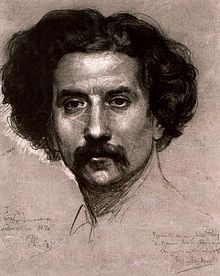Ramon Martí i Alsina
Ramon Martí i Alsina (born August 10, 1826 in Barcelona ; † December 21, 1894 ibid ) was a Catalan painter who introduced realism into Catalan painting. With this change in artistic style or style break, he brought the Catalan school of modern painting into being. As an art lecturer, he shaped many Catalan painters of the next generation, such as Joaquim Vayreda .
life and work
When Ramon Martí was eight years old, his father died. Despite the family's financial difficulties caused by this death, Martí was able to study drawing at the Llotja in Barcelona from 1840 to 1844 . In 1845 he passed a high school diploma in humanities and philosophy. At the beginning of his career, Martí mainly painted portraits. At the same time, he translated humanities works from French. He also wrote romantically influenced dramas in verse form. These dramas were never published.
In 1850 he married Carlota Aguiló. In 1852 he was appointed professor of arithmetic and geometry at the Llotja. In 1854 he became a professor for personal representation at the same academy. During this time he went on study trips to Paris. There he was particularly inspired by the work of Gustave Courbet , which had revolutionized the world of painting since the mid-19th century. On the basis of this study experience Martí developed his own realistic style, especially in the technique of drawing, the use of colors and the representation of light. Thematically, Martí reflected on his environment, i.e. the landscape and the inhabitants of Catalonia. As one of the first Catalan painters, in contrast to the pure studio painters, he went into nature and made sketches there, which he further developed into mature canvas works in the studio. The artistic content contrasts sharply on the one hand with the Catalan Nazarenes of the time and on the other hand with the pompous historical painting customary in Spain. In 1858 he received a third prize in the National Exhibition of Fine Arts in Madrid; In 1860 he received a second prize in the same competition. In 1859 he became a member of the "Acadèmia de Belles Arts" (Academy of Fine Arts) in Barcelona. In 1866 he resigned from this academy for political reasons. Martí represented republican, liberal values. He also showed a tendency towards atheism and anti-clericalism. All of this was revealed in his works. In 1870 he also gave up the professorship at the Llotja. He would not and could not swear by the constitution of 1869 , on the basis of which Amadeus I of Spain had been crowned. He would have seen such an oath as a betrayal of the revolution of 1868 . In 1873, during the First Spanish Republic , Martí regained his professorship at the Llotja.
In the late 1860s, Martí changed his purely realistic art style of analytical forms to a more synthetic style with numerous artistic effects. He expanded his previous subject area of depicting people, landscapes and urban images to include nude, female figures, coastal landscapes, still lifes, allegories, scenes of customs and traditions as well as historical images. A striking example of his history painting is the painting “Els Defensors de Girona” (“The Defenders of Girona”) measuring 11 meters in width.
In 1878 his first wife died. Following this stroke of fate, he undertook a trip to Paris, which probably also took him to Belgium and Holland. After his return he made pictures in almost industrial production. He worked with several studios in which employees produced pictures according to his specifications, which he then overworked or finished. He often signed such pictures at the end of the manufacturing process. His artistic reputation was damaged and economic success also failed. It was said that he signed more than 4,000 oil paintings during this period. By 1870 he probably had around 1200 drawings in stock in his portfolio.
In 1889 he married Francisca Chillida. Towards the end of his life he returned to his outstanding painting qualities. He now embodied the solitary painter genius again. In his later work he sought and found new forms of artistic expression, especially in the brush strokes. This technique came very close to the painting techniques of Impressionism .
Martí is considered to be the pioneer of realism in the visual arts of Catalonia. As a professor at the Llotja, he has numerous artists of the following generation such as Joaquim Vayreda , Modest Urgell i Inglada , Francesc Galofré i Oller , Ramon Tusquets i Maignon , Josep Lluís Pellicer i Fenyé , Francesc Torrescassana i Sallarés Josep Armet i Portanell and Jaume Pahissa i Laporta trained and shaped. Martí was the initiator of modern painting in Catalonia with his artistic commitment.
literature
- Gran Enciclopèdia Catalana , volume 14, 2nd edition, 5th reprint Barcelona 1992 (Enciclopèdia Catalana SA), ISBN 84-7739-011-8 (for volume 14); ISBN 84-85194-81-0 (for the complete work), page 436 f., Article Martí i Alsina, Ramon . (in Catalan)
- Martí i Alsina, Ramon on enciclopèdia.cat (in Catalan)
Web links
Individual evidence
- ↑ The exact date of birth and death is taken from the Spanish language Wikipedia.
| personal data | |
|---|---|
| SURNAME | Martí i Alsina, Ramon |
| ALTERNATIVE NAMES | Martí, Ramon |
| BRIEF DESCRIPTION | Spanish painter |
| DATE OF BIRTH | August 10, 1826 |
| PLACE OF BIRTH | Barcelona |
| DATE OF DEATH | December 21, 1894 |
| Place of death | Barcelona |


